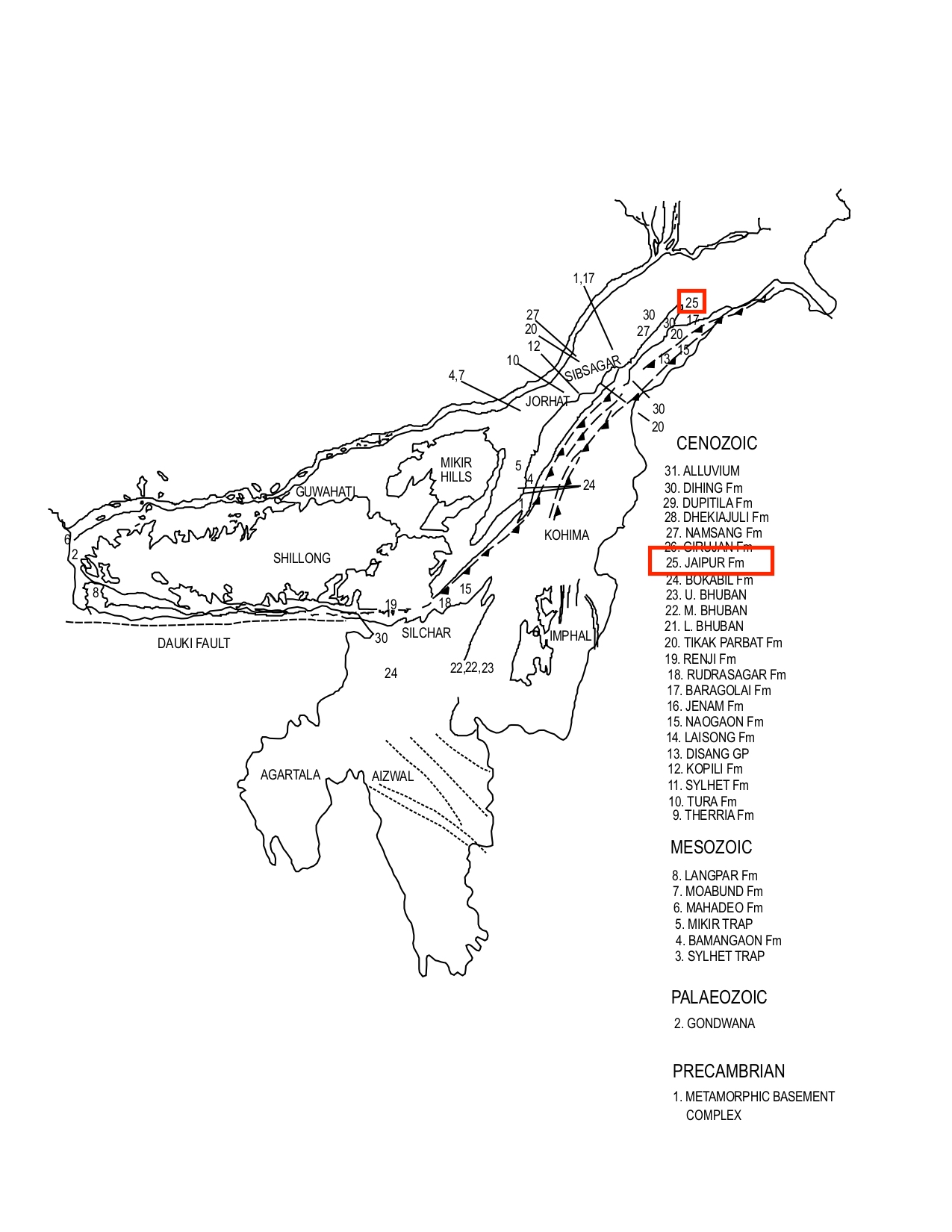Jaipur Fm
Type Locality and Naming
Lower formation of the Tipam Gr. The type section is in Dihing River section across the Tipam Hills. [Original Publication: Pandey J. 1982: Chronostratigraphic correlation of the Neogene sedimentaries of Western Indian Shelf, Himalayas and Upper Assam, Spl.Publ.Pal.Soc.India,no.1,pp.95-129]. Reference well: Adamtilla Well-1, depth 0-1130 m.
Synonyms: Tipam Sandstone Fm. The erstwhile Tipam Sandstone Stage of Evans (1932) and of later workers was renamed as Jaipur Formation by Pandey (1982) in view of usage of Tipam nomenclature for the Group rank. Jaipur Sandstone is another synonym.
[Figure 1: Geological set up and formation stratotypes of North East Basins (modified after Pandey and Dave, 1998)]
Lithology and Thickness
Sandstone to claystone. In the type section along Dihing river section, the lower part of Jaipur Fm is composed of coarse ferruginous sandstones with very thin clay and thin grit beds with fine conglomerates. It is followed upwards by alternations of blue and mottled clay, mudstones, shaly sandstones and sandstones, overlain by a sequence of moderately coarse ferruginous sandstones.
In the reference sections of Upper Assam, the formation is divided into a lower Geleki Member and an Upper Nazira Member characterized by the dominance of clays and sandstones respectively.
In the Schuppen Belt the thickness varies between 1300 m to 2300 m, the maximum being observed along the Merapani-Wokha road section. In the Fold Belt, a thickness of over 2000 m is present in the synclinal parts in Tripura, while in Mizoram on the east, it reduces to about 900 m. In Cachar, the Jaipur Fm occupies the cores of eroded anticlines in the western part. In Cachar, the formation thickens towards southwest in contrast to the Schuppen Belt where it thickens due northeast.
Relationships and Distribution
Lower contact
In Surma valley of Adamtilla Well-1, this formation rests conformably over the Bokabil Fm.
Upper contact
The formation has gradational contact with the Girujan Fm (Girujan Clay) or Gobindpur Fm.
Regional extent
Upper Assam Shelf, Naga Schuppen Belt, Tripura-Cachar, SE Bangladesh: Outcropping Tipam Sandstone (Jaipur Fm) deposits occur throughout the Frontal Fold Belt from the southernmost portion of the Chittagong Hill Tracts, through the western section of the Indian state of Mizoram and across Tripura to the northeastern section of the Surma Basin. The formation occurs regularly on the flanks of the anticlinal trends in the Frontal Folded Belt area, forming steep cliffs.
In the southerly area of Upper Assam, the Namsang Fm Sandstone merges with the Jaipur Fm Sandstone to form an indifferentiated Tipam Gr. In the areas north of Barail ranges i.e., Tripura-Cachar, it includes the Namsang equivalent beds overlying the Bokabil Fm claystones. In the northeastern part of Schuppen Belt the lateral variation in Jaipur Formation is well marked.
GeoJSON
Fossils
No reports on microfauna. The microfloral assemblage found in this formation is featured by the dominance of gymnospermous pollen and monoporate pollen grains belonging to the Gramineae. The poor preservation of the palynomorphs can be linked with repeated deposition, erosion and redeposition and subaerial conditions prevailing during deposition
Age
Depositional setting
Additional Information
Banglapedia (National Encyclopedia of Bangladesh as compiled by several geologists; http://en.banglapedia.org/index.php/Geological_Group-Formation; 2015)
